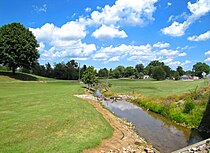Loudon County, Tennessee
[3] Loudon County is included in the Knoxville, TN Metropolitan Statistical Area.
The fort was named for John Campbell, 4th Earl of Loudoun and a commander of British forces during the French and Indian Wars.
On September 5, 1870, the county court was organized at the Baptist Church in Loudon.
This church became the temporary quarters of the county court until the new building, built by J. W. Clark & Brothers, was finished in 1872.
[4] Bussell Island, at the mouth of the Little Tennessee River, was inhabited by Native Americans for several thousand years before the arrival of the region's first European settlers.
[6] Fort Loudoun was constructed by the British near modern Vonore in 1756, and was destroyed by the Cherokee four years later.
[8] The town of Loudon began as a ferry and later steamboat stop known as Blair's Ferry, established by James Blair and his brother-in-law, John Hudson Carmichael, in the 1810s.
The town changed its name to "Loudon" during the early 1850s, when it expanded following the arrival of the railroad.
[9] The railroad bridge at Loudon was one of eight bridges targeted for destruction by Union guerillas as part of the East Tennessee bridge-burning conspiracy in November 1861, at the outset of the Civil War.
The bridge was too well-guarded by Confederate sentries, however, and the guerillas abandoned the effort.
The section of the river downstream from Fort Loudoun Dam is part of Watts Bar Lake.
As of the 2020 United States census, there were 54,886 people, 20,669 households, and 14,615 families residing in the county.



